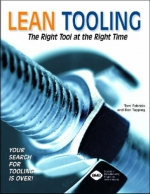The purpose of Lean Tooling is simple: to ensure that the right tool, in good condition, is in the hands of the right person, at the right time, in the right place. To do that, the authors have created a unique five-phase process. This text targets tools and tooling. But so much waste has grown around tools and tooling that you must deal with equipment, processes, and people as well. The job of Lean Tooling is to eliminate all waste in the process while it performs its purpose. After all, anybody can do it with lots of money. Lean Tooling goes far beyond quick changeovers, setup reductions, and the 5S program. It provides autonomous maintenance for tooling, a kanban for tooling program, complete standardization, and visual control systems.
A Message From the Authors
Keys to Successful Implementation
Key One
Key Two
Key Three
Key Four
Phase I : Prepare the Project
Step 1 : Get Management Involvement
Step 2 : Identify Target Area(s)
Step 3 : Form a Core Implementation Team
Phase II : Study the Problem
Step 4 : Select Tooling Measures
Step 5 : Collect Baseline Data
Step 6 : Photograph Current Conditions
Step 7 : Apply Lean Tooling Diagnostic Checklist
Step 8 : Write a Target Statement
Step 9 : Post a Project Visual Display
Phase III : Implement the Workplace 3S’s
Step 10 : Sort Through and Sort Out
Step 11 : Set Things In Order
Step 12 : Shine and Inspect Through Cleaning
Phase IV : Standardize Tooling
Step 13 : Draw Area Map and Arrow Diagram
Step 14 : Create New Tooling Standards
Step 15 : Bring Order to Tools and Tooling
Step 16 : Redesign the Workplace
Step 17 : Implement Tooling Visual Controls
Phase V : Stabilize Tooling
Step 18 : Apply Quarterly Tooling Audits
Step 19 : Implement On-error Training
Step 20 : Continue to Improve

























